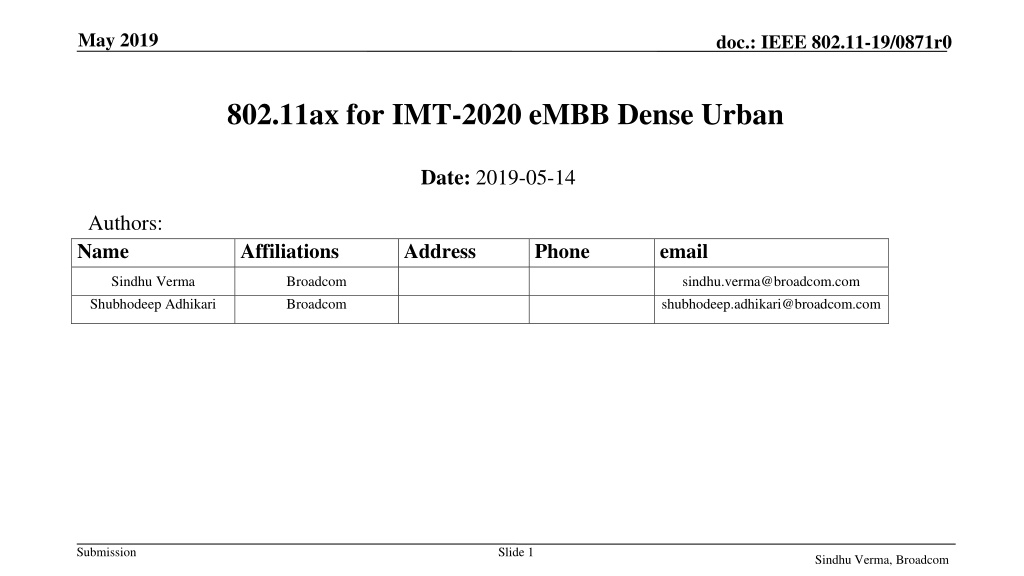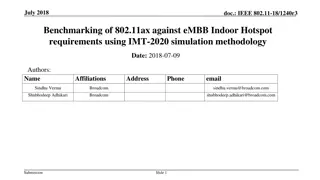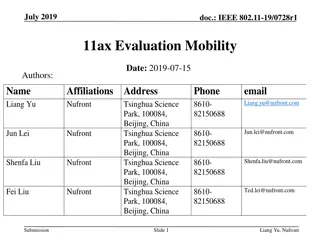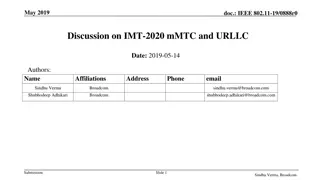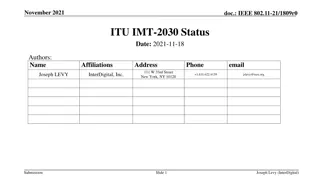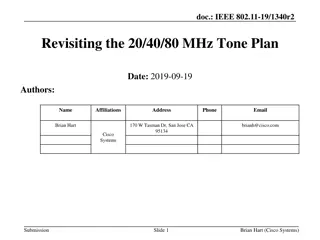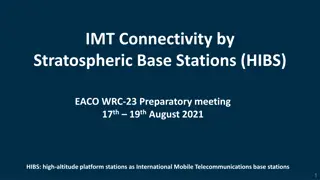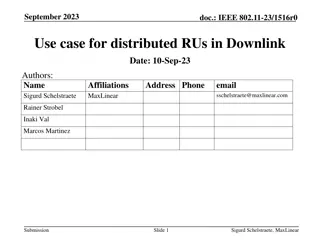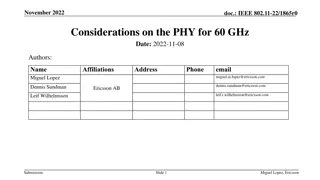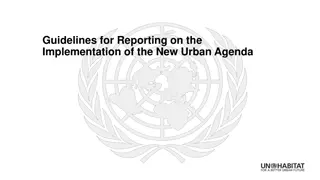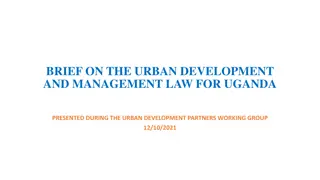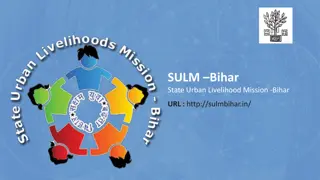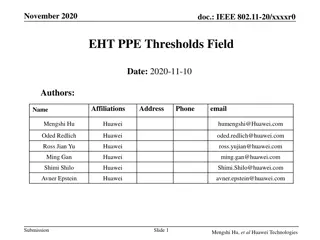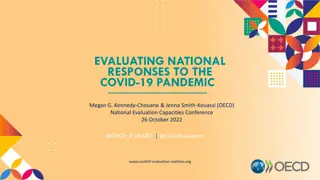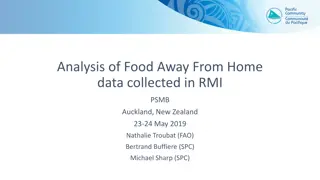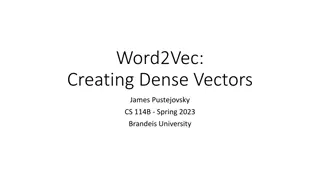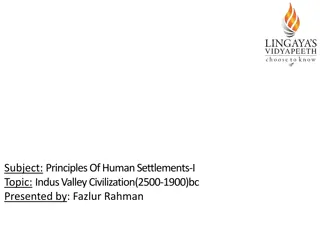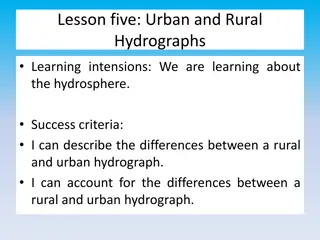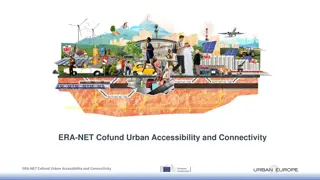802.11ax Evaluation for IMT-2020 eMBB in Dense Urban Environments
The document presents a detailed analysis of the 802.11ax technology's performance in meeting IMT-2020 requirements for eMBB in dense urban settings. It includes results from simulations evaluating peak spectral efficiency, data rates, user experience, and mobility metrics. The study confirms 802.11ax capabilities in indoor hotspot and dense urban scenarios through analytical approaches and adherence to ITU-R methodology.
Download Presentation

Please find below an Image/Link to download the presentation.
The content on the website is provided AS IS for your information and personal use only. It may not be sold, licensed, or shared on other websites without obtaining consent from the author. Download presentation by click this link. If you encounter any issues during the download, it is possible that the publisher has removed the file from their server.
E N D
Presentation Transcript
May 2019 doc.: IEEE 802.11-19/0871r0 802.11ax for IMT-2020 eMBB Dense Urban Date: 2019-05-14 Authors: Name Affiliations Address Phone email Sindhu Verma Shubhodeep Adhikari Broadcom Broadcom sindhu.verma@broadcom.com shubhodeep.adhikari@broadcom.com Submission Slide 1 Sindhu Verma, Broadcom
May 2019 doc.: IEEE 802.11-19/0871r0 Abstract In [1], [2], [3] and [4], we have documented the results of benchmarking of 802.11ax [5] capabilities in the eMBB Indoor Hotspot test environment defined by IMT-2020 ([6], [7]). This confirmed that 802.11ax [5] meets the salient IMT-2020 requirements for the eMBB Indoor Hotspot, including mobility. In [4], we had used an analytical approach using the IMT and 3GPP configurations to conclude that 802.11ax can meet the requirements of eMBB Dense Urban test environment. Dense Urban-eMBB: an urban environment with high user density and traffic loads focusing on pedestrian and vehicular users [6] This presentation details the results of simulations regarding 802.11ax capabilities for DL and UL aspects of IMT-2020 requirements for eMBB Dense Urban. These simulations adhere to the methodology specified by ITU-R for self-evaluating a RAT for IMT-2020 ([6] and [7]). Submission Slide 2 Sindhu Verma, Broadcom
May 2019 doc.: IEEE 802.11-19/0871r0 Background According to the IMT-2020 self-evaluation criteria, a candidate RAT needs to meet the minimum requirements for the following metrics for eMBB Dense Urban: Peak Spectral Efficiency Peak Data Rate 5%ile User Spectral Efficiency User Experienced Data Rate Average Spectral Efficiency Mobility The above metrics must be evaluated as follows: Peak Spectral Efficiency and Peak Data Rate must be evaluated analytically. 5%ile User Spectral Efficiency, Average Spectral Efficiency and Mobility must be evaluated based on the simulation methodology specified by ITU-R. User Experienced Data Rate is derived from 5%ile User Spectral Efficiency Submission Slide 3 Sindhu Verma, Broadcom
May 2019 doc.: IEEE 802.11-19/0871r0 Simulation setup The simulations follow the self-evaluation methodology specified by ITU-R ([6] and [7]). The simulator is calibrated with respect to salient channel model parameters such as the geometry SINR, coupling loss, singular values, delay spread, spread of azimuth/elevation departure/arrival angles. IMT-2020 simulation data presented by multiple companies in 3GPP ([8]) was used as the calibration benchmark. We also made the following assumptions: Antenna configuration: A configuration inferior to what is permitted by ITU (refer to slide 6) MU-MIMO factor: Limited to a maximum factor of 4 Interference: No use of schemes that can reduce interference such as Interference Coordination and Cancellation, Partial Frequency Reuse etc. Scheduling: Simple equal-time scheduler targeting a PER of 10% Submission Slide 4 Sindhu Verma, Broadcom
May 2019 doc.: IEEE 802.11-19/0871r0 Network Topology 1. The eMBB Dense Urban network topology consists of one or two layers, a macro layer and an optional micro layer ([6]). The macro layer base stations are placed in a regular grid, following hexagonal layout with 3 TRxPs each. 2. The simulation is a wrap-around configuration of 19 sites, each of 3 TRxPs (per macro cell) with a macro Inter-Site-Distance of 200m. 3. UEs are distributed uniformly over the whole area. 4. There are 3 configurations, A (4 GHz macro), B (30 GHz macro) and C (4 GHz and 30 GHz, macro + micro). It suffices to evaluate the requirements for any one configuration. 5. For our evaluations, we have used configuration A (4 GHz macro). Submission Slide 5 Sindhu Verma, Broadcom
May 2019 doc.: IEEE 802.11-19/0871r0 Simulation configuration and parameters per Configuration A (1) Carrier Frequency : 4 GHz (single layer Macro) Simulation bandwidth : 20 MHz (TDD) BS antenna height: 25m UE antenna height: Outdoor UEs: 1.5 m, Indoor UTs: 3(nfl 1) + 1.5; nfl ~ uniform(1,Nfl) where Nfl ~ uniform(4,8) Total transmit power per TRxP: 44 dBm UE power class: 23 dBm Number of antenna elements per TRxP: Up to 256 Tx/Rx Number of UE antenna elements: Up to 8 Tx/Rx BS noise figure: 5 dB UE noise figure: 7 dB BS antenna element gain: 8 dBi UE antenna element gain: 0 dBi Thermal noise level: 174 dBm/Hz Submission Slide 6 Sindhu Verma, Broadcom
May 2019 doc.: IEEE 802.11-19/0871r0 Simulation configuration and parameters per Configuration A (2) Percentage of high loss and low loss building type : 20% high loss, 80% low loss Traffic model: Full buffer UE density: 10 UEs per TRxP UE speeds of interest: Indoor users: 3 km/h, Outdoor users (in-car): 30 km/h Device (UE) deployment: 80% indoor, 20% outdoor (in-car) randomly and uniformly distributed over the area under Macro layer UE mobility model: Fixed and identical speed of all UEs of the same mobility class, randomly and uniformly distributed direction. Channel model: UMa The complete configuration is specified in the ITU-R guidelines ([6] and [7]). Submission Slide 7 Sindhu Verma, Broadcom
May 2019 doc.: IEEE 802.11-19/0871r0 Metrics evaluated The following metrics for eMBB Dense Urban have to be evaluated via simulations: 1. 5%ile DL User Spectral Efficiency 2. 5%ile UL User Spectral Efficiency 3. DL User Experienced Data Rate 4. UL User Experienced Data Rate 5. DL Average Spectral Efficiency 6. UL Average Spectral Efficiency Note: 1. eMBB Dense Urban also requires analytical evaluation of Peak Spectral Efficiency and Peak Data Rate and these have already been provided in [4]. 2. Mobility [7] requires separate simulations and has not yet been evaluated. We plan to provide them later. Submission Slide 8 Sindhu Verma, Broadcom
May 2019 doc.: IEEE 802.11-19/0871r0 Metrics : 5%ile DL and UL spectral efficiencies Definition: 5th percentile user spectral efficiency is the 5th percentile point of the cumulative distribution function (CDF) of the normalized user throughput, estimated from all possible user locations. The requirement for eMBB Dense Urban is [7]: DL: 0.225 bits/s/Hz UL: 0.15 bits/s/Hz Submission Slide 9 Sindhu Verma, Broadcom
May 2019 doc.: IEEE 802.11-19/0871r0 Metrics : DL and UL User Experience Data Rate Definition: User experienced data rate is the 5% point of the cumulative distribution function (CDF) of the user throughput. User throughput (during active time) is defined as the number of correctly received bits, i.e. the number of bits contained in the service data units (SDUs) delivered to Layer 3, over a certain period of time. In case of one frequency band and one layer of transmission reception points (TRxP), the user experienced data rate could be derived from the 5th percentile user spectral efficiency. Let W denote the channel bandwidth and SEuser denote the 5th percentile user spectral efficiency. Then the user experienced data rate, Ruser is given by: Ruser = W SEuser. If the bandwidth is aggregated across multiple bands (one or more TRxP layers), the user experienced data rate is summed over the bands. The requirement for EMBB Dense Urban is [7]: DL: 100 Mbit/s UL: 50 Mbit/s Submission Slide 10 Sindhu Verma, Broadcom
May 2019 doc.: IEEE 802.11-19/0871r0 Metrics : Average DL and UL spectral efficiencies Definition: Average spectral efficiency is the aggregate throughput of all users (the number of correctly received bits, i.e. the number of bits contained in the SDUs delivered to Layer 3, over a certain period of time) divided by the channel bandwidth of a specific band divided by the number of TRxPs and is measured in bit/s/Hz/TRxP. The channel bandwidth for this purpose is defined as the effective bandwidth times the frequency reuse factor, where the effective bandwidth is the operating bandwidth normalized appropriately considering the uplink/downlink ratio. Let Ri (T) denote the number of correctly received bits by user i (downlink) or from user i (uplink) in a system comprising a user population of N users and M TRxPs. Furthermore, let W denote the channel bandwidth and T the time over which the data bits are received. The average spectral efficiency, SEavg is then defined according to equation: The requirement for EMBB Dense Urban is [7]: 1. DL: 7.8 bits/s/Hz/TRxP 2. UL: 5.4 bits/s/Hz/TRxP Submission Slide 11 Sindhu Verma, Broadcom
May 2019 doc.: IEEE 802.11-19/0871r0 Metric : Mobility Mobility requirement for eMBB Dense Urban is met if at the 50%ile SINR CDF for Dense Urban at 30 kmph, the technology satisfies a UL spectral efficiency of 1.12 bits/s/Hz and also the residual decoded packet error ratio is less than 1% [7]. Submission Slide 12 Sindhu Verma, Broadcom
May 2019 doc.: IEEE 802.11-19/0871r0 Summary of evaluations for EMBB Dense Urban ITU-R Evaluation Method Analytical Metric Minimum Requirement 802.11ax Performance Peak data rate DL/UL: 20/10 Gbps 1 DL/UL: 20.78 Gbps [Note 1] Peak spectral efficiency Analytical DL/UL: 30/15 bits/s/Hz DL/UL: 58.01 bits/s/Hz [Note 2] 2 Analytical for single band and single layer; Simulation for multi- layer User experienced data rate DL/UL: 100/50 Mbit/s DL/UL: 113.6/81.6 Mbps [Note 3] 3 5thpercentile user spectral efficiency DL/UL: 0.225/0.15 bits/s/Hz Simulation DL/UL: 0.71/0.51 bits/s/Hz 4 DL/UL = 7.8/5.4 bits/s/Hz/TRxP UL: 1.12 bits/s/Hz 100 MHz, scalable Average spectral efficiency Simulation DL/UL: 10.84/8.75 bits/s/Hz/TRxP 5 Mobility Bandwidth Simulation Inspection Not yet evaluated 20/40/80/80+80/160 MHz 6 7 1. 2. 3. Assumes a three carrier configuration: 8x8 HE160 + 8x8 HE160 + 8x8 HE40. Assumes an 8x8 configuration. Assumes 160MHz transmission bandwidth only. It is possible for 802.11ax to support a higher three carrier transmission bandwidth of (160+160+40) MHz. Submission Slide 13 Sindhu Verma, Broadcom
References May 2019 doc.: IEEE 802.11-19/0871r0 [1] IEEE 802.11-18/1573r7, Summary of 802.11ax Self Evaluation for IMT-2020 EMBB Indoor Hotspot, November, 2018 [2] IEEE 802.11-18/1240r4, Benchmarking of 802.11ax against eMBB Indoor Hotspot requirements using IMT- 2020 simulation methodology, November, 2018 [3] IEEE 802.11-18/0915r3, Benchmarking of 802.11ax against eMBB Indoor Hotspot requirements using IMT- 2020 simulation methodology, November, 2018 [4] IEEE 802.11-18/0517r2, 802.11ax for IMT-2020 EMBB Indoor Hotspot and Dense Urban, September, 2018 [5] IEEE P802.11ax /D3.0, Draft Standard for Information technology Tele-communications and information exchange between systems Local and metropolitan area networks Specific requirements Part 11: Wireless LAN Medium Access Control (MAC) and Physical Layer (PHY) Specifications; Amendment 6: Enhancements for High Efficiency WLAN June 2018 [6] Report ITU-R M.2412-0 (10/2017), Guidelines for evaluation of radio interface technologies for IMT-2020 [7] Report ITU-R M.2410-0 (11/2017), Minimum requirements related to technical performance for IMT-2020 radio interface(s) [8] RT-170019, Summary of email discussion [ITU-R AH 01] Calibration for self-evaluation , Huawei, December 2017 Submission Slide 14 Sindhu Verma, Broadcom
